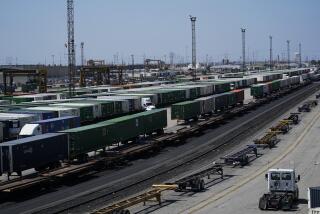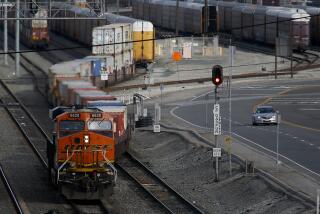Railing at Noisy Railroads
- Share via
At first glance, Astor Avenue in Commerce looks like a peaceful residential street where children ride bikes in the evening and neighbors lean over frontyard fences to chat about the day’s events.
Then the rumbling starts. Screeching whistles pierce the air. A smoky cloud rises over the rooftops. Neighbors grimace, cover their ears, mutter in frustration.
Their grief comes from a busy railroad track that runs about 10 feet behind the Astor Avenue homes, on the other side of a concrete wall, inside a massive Union Pacific rail yard.
“The noise will pierce your brain until you don’t know what to do about it,” said an exhausted Jeanette Baca, whose bedroom is just a few paces from the tracks. “You don’t sleep here. We’re just worn out, all of us.”
Some decades back, when many of the residents moved in, the yard was relatively quiet. Not so anymore. In the past 10 years, train traffic has jumped 56% on the tracks between the ports of Los Angeles and Long Beach and the rail yards in Commerce, Vernon, East Los Angeles and near downtown Los Angeles, according to rail officials. The increase is related largely to a booming American economy and, more recently, by improvements in the Asian markets that ship goods through the ports.
The trains also are longer and heavier because many are double-stacked with 40-foot containers destined for markets across the country.
Although many people applaud the boom in railroad activity as a sign of a healthy economy, residents near the tracks and rail yards say that the trains are ruining their quality of life.
Many blue-collar communities south and east of downtown often are defined by the tracks that crisscross these neighborhoods, bisect residential streets, paralyze traffic. The biggest effects have been felt in densely populated communities from El Sereno to Long Beach, in a 20-mile-long corridor between the Harbor Freeway on the west and the Long Beach Freeway on the east.
The soundtrack of residents’ days and nights are the trains’ whistles, the wheels’ rumblings and boxcars’ shudders. Some rail neighbors have been driven to extremes, popping anti-anxiety medication, hiding behind furniture when the shaking starts, even nailing plywood over windows to block out train noise.
When trains stop too long at road crossings in Vernon and Wilmington, impatient pedestrians have climbed between the train cars to get to the other side, risking serious injury or death. Railroad neighbors complain that trains kick up dust and churn out diesel fumes. The bright lights of the rail yards illuminate their homes. And when railroad lines are abandoned or infrequently used, residents say, the right of ways become a no-man’s land that attracts crime and illegal dumping.
Inundated with such complaints from constituents, state and local officials are pressing railroad companies to alleviate the problems. Last May, U.S. Rep. Lucille Roybal-Allard (D-Los Angeles) asked the Federal Railroad Administration to investigate the concerns of the residents in Commerce. Federal officials said they are studying the issues and meeting with the Union Pacific Railroad. Los Angeles County prosecutors have filed complaints against the railroads for blocking traffic in Vernon. But in most cases, state and local leaders have little recourse because railroads are regulated by federal agencies.
Alameda Corridor May Give Relief
There may be some relief in the next few years.
Some of the increased rail traffic will be absorbed by the $1.8-billion Alameda Corridor, a 20-mile expressway for freight trains that will link the Los Angeles and Long Beach ports--the two busiest in the nation--with the rail yards near downtown Los Angeles. The corridor, which is expected to be finished in 2002, will allow trains to run along a concrete trench for 10 miles, with a series of overpasses to eliminate traffic congestion.
The project will create one high-speed corridor to replace four train lines that now carry about 30 trains a day--up to 8,000 feet in length--through such cities as Carson, Compton, Lynwood, Huntington Park, South Gate and parts of south Los Angeles.
By 2020, that number on the corridor is expected to jump to about 100 trains.
But the Alameda Corridor won’t solve all of the problems. Some of the increased train traffic--no one knows how much--will continue to roll through residential communities to deliver goods to businesses on local spurs along the tracks. Rail yards, such as the one near Astor Avenue in Commerce, will be busier than ever.
“The notion that the corridor will be a panacea and will solve all the problems is unrealistic,” said Mike Furtney, a spokesman for Union Pacific. “That is like saying one new freeway will take all the pressure from all the traffic in L.A.”
The corridor project will concentrate most of the noise and air pollution in neighborhoods along Alameda Street.
Meanwhile, rail officials reject complaints that they are unresponsive to residents along the tracks.
“We take all residential concerns seriously,” said Lena Kent, a spokeswoman for Burlington Northern and Santa Fe Railway, which along with Union Pacific Railroad are the freight companies that serve the region.
Rail officials defend their operations, saying that the rail lines are cheaper, generate fewer emissions and cause fewer deaths when compared to hauling cargo by big rig trucks.
In fact, train accidents at grade crossings in California and nationwide have dropped dramatically in the past 15 years with the improvement of signal systems, crossing gates and warning lights, federal and state officials said.
Train accidents in Los Angeles County have followed the national trend. Last year, the county had 44 accidents at grade crossings for freight lines and Amtrak and Metrolink passenger lines, down from 55 in 1989, state officials said. The figures do not include accidents on the light rail commuter Metro Blue Line.
Railroad Boom Helps Businesses
The increased train traffic has benefited many Southern California businesses, particularly companies that transfer cargo from the trains to the final destinations.
Rail Delivery Services, a La Mirada trucking company, has seen business jump up 30% each year for the past five years, causing the company to hire 25 additional drivers.
Dayle Frisk, executive director of the Industrial Council, an association of Commerce businesses, said many local companies rely on rail. “If they didn’t have that capacity here, they’d move to where they could get it,” he said.
One example is Cargill Inc., a bulk food handling company in Lynwood that receives its products, such as groceries for supermarkets, daily from a rail spur that parallels Alameda Street.
“We have been part of an industry that has grown and the railroad has been an integral part of that,” said Cargill manager Edward Oertel. The business opened in 1986 and employs six workers.
Rail officials say that residents who bought or built homes near train tracks should have expected some inconveniences.
“If you are near a railroad track, you are going to hear railroad noises,” Furtney said.
But many residents say the rail traffic and noise were bearable when they moved into their homes years ago. Now they say they feel trapped, unable to sell their properties.
Ana Ruiz and her family bought their brown stucco home on Independence Avenue in South Gate 10 years ago and weren’t bothered by the trains that occasionally rumbled along the Union Pacific tracks about 10 yards in front of her house.
Now the trains come more often--even as late as 2 a.m, Ruiz said. Her three young daughters are so scared of the train rumblings that they hide behind furniture when a train passes.
“Sometimes the earth shakes like it’s an earthquake,” she said.
In Commerce, the rail yard for many years was a traditional switching station. But in the late 1980s, Union Pacific added a new “intermodal” operation, which uses huge cranes to unload 40-foot containers from incoming trains and load them onto big rig trucks and outgoing trains.
Last March, frustrated Commerce neighbors met with railroad representatives to complain about the rail yard. Train officials responded by transferring a portion of the intermodal operation to the port areas.
But neighbors say the problems have continued.
“We can see it escalating month to month and we’re saying, ‘Help, help,’ ” said Diane Hughes. “But we don’t see anybody coming to our rescue.”
Barbara Baltierra said horn blasts woke her up just before 3 a.m. on a recent night. She lay in bed and counted 52 shrill whistles, all in a row.
“I called the railroad to complain and they said, ‘This is a 24-hour operation,’ ” she said. “It’s ridiculous.”
Now she gets so angry at the idling engines that she throws tomatoes from her father’s garden over the wall.
Other neighbors say that train engineers in the yard sometimes play “horn tag,” using the 90-decibel train horns to sound the old jingle “Shave and a haircut, two bits.” One train plays the first five notes and the second responds with the two final blasts.
Such horn playing is forbidden under federal guidelines, which regulate when the horns can be used, the volume and even the sound pattern.
Some rail yard neighbors say they suffer headaches, breathing problems and nosebleeds, which they blame on the diesel fumes from the idling train engines.
Regionwide, trains emit half a ton of potentially cancer-causing fine particulates per day, said Bill Kelly, spokesman for the South Coast Air Quality Management District.
Close contact with those emissions can cause respiratory ailments and nausea, he said.
The AQMD filed an abatement order against Union Pacific after residents near a rail yard in Colton complained of similar problems, Kelly said. The railroad contested the agency’s authority in federal court. A decision is pending.
Trash Heaps Criticized
Tina Romero, another neighbor of the Commerce rail yard, is on anti-anxiety medication and said the stress of the noise has given her an ulcer. She’s been rushed to the hospital four times, she said, thinking that she was having a heart attack because of the trains.
“When I hear the noise, I get extremely agitated,” said Romero, who added that she can’t work because she gets no sleep. “My heart races. I’m totally dysfunctional as a normal human being.”
In Watts, residents complain that infrequently used rail lines become trash heaps. They want rail companies to clean the mess and authorities to crack down on illegal dumping.
“If [the railroads] clean it today, it will be trashed next week” unless police act, said Jose Samudio, a mechanic at a Watts auto shop that abuts a litter-strewn Union Pacific rail line near Lanzit Avenue.
Rail officials acknowledge that they can’t keep up with the illegal dumping problem.
In Vernon, a heavily industrial community that is crisscrossed by rail lines, business owners and workers have complained about trains that stop at road crossings for up to 40 minutes, causing traffic nightmares citywide. Vernon fire officials sometimes are forced to dispatch a second emergency crew to distress calls when the first crew is stuck at a railroad crossing.
The problem was so bad last year that Vernon police cited rail companies under a state law that prohibits trains from stopping at crossings for more than 10 minutes. Burlington Northern admitted to violating the law three times last year and has paid $1,000 for each offense, according to the Los Angeles County district attorney’s office.
Rail officials said trains sometimes stop at road crossings because of mechanical problems or to allow trains on other tracks to pass. The rail companies say that they are trying to reduce the delays through better planning.
Delores Petullo, general manager of the Vernon Chamber of Commerce, said she has seen frustrated workers climb between the stopped train cars to avoid being late for work. Operations of many Vernon businesses are disrupted by delayed workers, she said.
In Wilmington, Burlington Northern has mostly stopped running trains near an elementary school in the mornings and afternoons since Los Angeles City Atty. James K. Hahn threatened to prosecute the rail company for allegedly blocking the students’ route to school.
The halted trains became a hazard when children began climbing between the train cars to get to school.
In El Sereno, a hilly community just east of downtown, train noise is driving Alicia and Manuel Perez to drastic action.
The couple bought the 1910 stucco house on Valley Boulevard more than 20 years ago, when the traffic on the tracks across the street from their home was infrequent, they said. But the railroad added a switching yard nearby, and now long trains constantly chug past their home.
To sleep, Alicia Perez keeps earplugs near her bed and takes sleeping pills. During the day, she turns up the TV to drown out the clacking of wheels against the rails. But nothing works.
“I don’t want to be here,” she said, her eyes welling with tears. “I can’t take it anymore.”
About eight months ago, Manuel Perez became so frustrated that he boarded up his home’s windows with plywood and cardboard. The barriers help but only a little.
The couple moves around the dark house, depressed, “like zombies,” he said.
“We live like in a prison,” Manuel Perez said. “This place looks like a crack house. I almost want to walk away from the house and all the furniture, and just leave here.”
(BEGIN TEXT OF INFOBOX / INFOGRAPHIC)
Train Traffic
Rail traffic between the ports of Los Angeles and Long Beach and the rail yards near downtown Los Angeles has increased 56% since 1989. The rail yards and lines are concentrated in blue-collar communities south and east of downtown.
More to Read
Sign up for Essential California
The most important California stories and recommendations in your inbox every morning.
You may occasionally receive promotional content from the Los Angeles Times.











